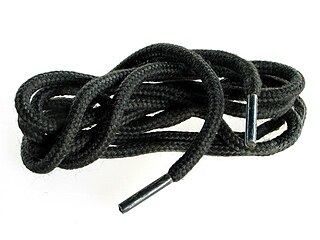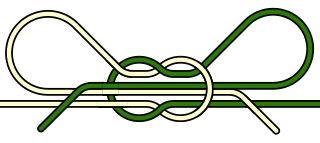
A knot is an intentional complication in cordage which may be practical or decorative, or both. Practical knots are classified by function, including hitches, bends, loop knots, and splices: a hitch fastens a rope to another object; a bend fastens two ends of a rope to each another; a loop knot is any knot creating a loop; and splice denotes any multi-strand knot, including bends and loops. A knot may also refer, in the strictest sense, to a stopper or knob at the end of a rope to keep that end from slipping through a grommet or eye. Knots have excited interest since ancient times for their practical uses, as well as their topological intricacy, studied in the area of mathematics known as knot theory.

The granny knot is a binding knot, used to secure a rope or line around an object. It is considered inferior to the reef knot, which it superficially resembles. Neither of these knots should be used as a bend knot for attaching two ropes together.
The granny knot is also called the false, lubber's, calf, and booby knot. Patterson's Nautical Encyclopedia calls it "old granny knot" and Sir Edwin Arnold calls it the "common or garden knot." The name granny is given in Vocabulary of Sea Phrases and Roding pictures the knot in 1795.
The granny consists of two identical half knots, one tied on top of the other. It has but one practical purpose that I know of and that is to serve as a surgeon's knot. Formerly it was employed for tying up parcels in five-and-ten-cent stores, but the practice was given up and paper bags substituted as they were found to be simpler.

The thief knot resembles the reef knot except that the free, or bitter ends are on opposite sides. It is said that sailors would secure their belongings in a ditty bag using the thief knot, often with the ends hidden. If another sailor went through the bag, the odds were high the thief would tie the bag back using the more common reef knot, revealing the tampering, hence the name. It is difficult to tie by mistake, unlike the granny knot, unless one attempts to tie a square knot in a similar manner to a sheet bend, then it is possible to tie accidentally.
A whipping knot or whipping is a binding of marline twine or whipcord around the end of a rope to prevent its natural tendency to fray.

A Zeppelin bend is an end-to-end joining knot formed by two symmetrically interlinked overhand knots. It is stable, secure, and highly resistant to jamming. It is also resistant to the effects of slack shaking and cyclic loading.

A grief knot is a knot which combines the features of a granny knot and a thief knot, producing a result which is not generally useful for working purposes. The word grief does not carry its usual meaning but is a portmanteau of granny and thief.
The common whipping is the simplest type of whipping knot, a series of knots intended to stop a rope from unravelling. As it can slip off the rope easily, the common whipping should not be used for rope ends that will be handled. This whipping knot is also called 'wolf' whipping in some parts of the world. The 'Hangman's knot' is a variation of this whipping knot.

Hunter's bend is a knot used to join two lines. It consists of interlocking overhand knots, and can jam under moderate strain. It is topologically similar to the Zeppelin bend.

Shoelaces, also called shoestrings or bootlaces, are a system commonly used to secure shoes, boots, and other footwear. They typically consist of a pair of strings or cords, one for each shoe, finished off at both ends with stiff sections, known as aglets. Each shoelace typically passes through a series of holes, eyelets, loops or hooks on either side of the shoe. Loosening the lacing allows the shoe to open wide enough for the foot to be inserted or removed. Tightening the lacing and tying off the ends secures the foot firmly within the shoe. The laces can be tied in different shapes, most commonly a simple bow.

A stopper knot is a knot that creates a fixed thicker point on an otherwise-uniform thickness rope for the purpose of preventing the rope, at that point, from slipping through a narrow passage, such as a hole in a block. To pass a rope through a block, or hole, is to reeve it. To pull it out is to unreeve it. Stopper knots prevent the rope from unreeving on its own.

The West Country whipping is a quick practical whipping knot, a method of using twine to secure the end of a rope to prevent it fraying. It has several advantages: it can be tied without a needle; it is simple to understand and remember; if the whipping fails, the loose ends can usually be re-tied to temporarily prevent the rope's end from fraying.
West Country whipping was the name given by Biddlecombe in 1848 to this particular practice, but most subsequent seamanship books, including the British Admiralty Manual of Seamanship, have modified the name to West County whipping...I have not seen this whipping used but it has this advantage: if any part breaks it will be a very long while before the whole whipping lets go. The break will be evident and the whipping can be replaced in time.

The sailmaker's whipping is one of the most durable and stable of rope whippings known. According to The Ashley Book of Knots, "palm-and-needle whipping, or sailmaker's whipping, is the most satisfactory of all."

In knot tying, a bight is a curved section or slack part between the two ends of a rope, string, or yarn. A knot that can be tied using only the bight of a rope, without access to the ends, is described as in the bight. The term "bight" is also used in a more specific way when describing Turk's head knots, indicating how many repetitions of braiding are made in the circuit of a given knot.

The shoelace knot, or bow knot, is commonly used for tying shoelaces and bow ties.

The basket weave knots are a family of bend and lanyard knots with a regular pattern of over–one, under–one. All of these knots are rectangular and lie in a plane. They are named after plait-woven baskets, which have a similar appearance.

The reef knot, or square knot, is an ancient and simple binding knot used to secure a rope or line around an object. It is sometimes also referred to as a Hercules knot. The knot is formed by tying a left-handed overhand knot between two ends, instead of around one end, and then a right-handed overhand knot via the same procedure, or vice versa. A common mnemonic for this procedure is "right over left; left over right", which is often appended with the rhyming suffix "... makes a knot both tidy and tight". Two consecutive overhands tied as described above of the same handedness will make a granny knot. The working ends of the reef knot must emerge both at the top or both at the bottom, otherwise a thief knot results.
The reef knot or square knot consists of two half knots, one left and one right, one being tied on top of the other, and either being tied first...The reef knot is unique in that it may be tied and tightened with both ends. It is universally used for parcels, rolls and bundles. At sea it is always employed in reefing and furling sails and stopping clothes for drying. But under no circumstances should it ever be tied as a bend, for if tied with two ends of unequal size, or if one end is stiffer or smoother than the other, the knot is almost bound to spill. Except for its true purpose of binding it is a knot to be shunned.

The Lapp knot or Lap knot is a bend, i.e. it is used to join two lines. It can also be used to form a fixed loop. It is very easy to tie, especially in the slipped form, since no end has to be pulled through the knot while tying, i.e. it can be tied in the bight for both lines, which makes tying it especially easy when the working ends are long. The slipped Lapp bend also is an exploding knot, which means that when pulling the quick release end it falls completely apart without further entanglement. It is as strong as or even stronger than the sheet bend, though much less common.

















